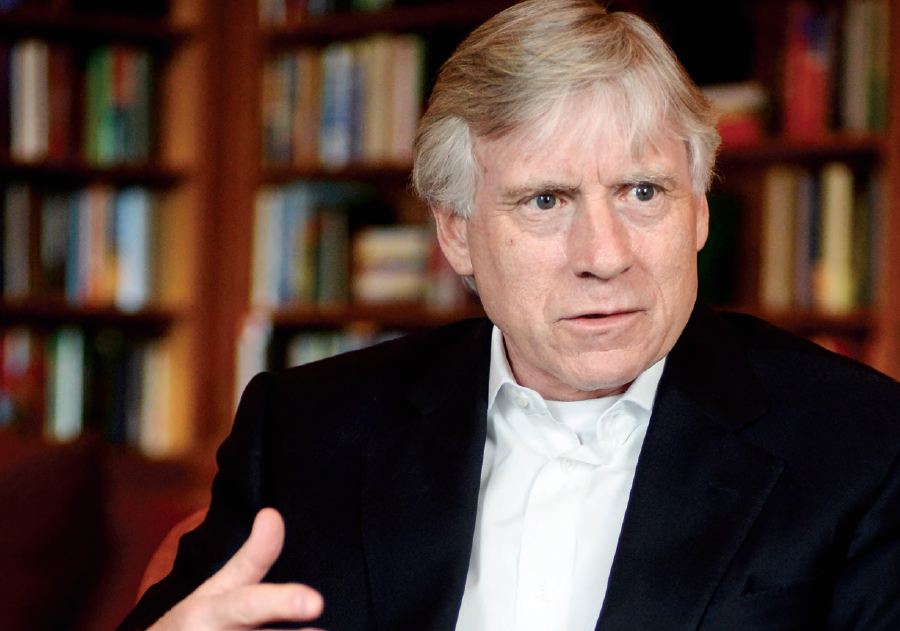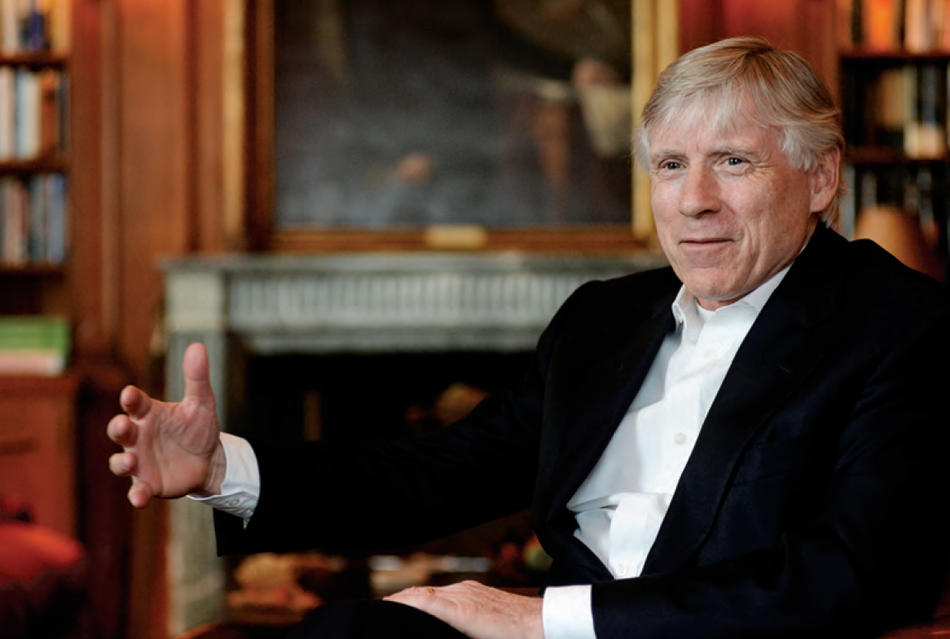
In January, you sent a letter to alumni describing the University’s recent campaign in powerful terms: its final tally of $6.1 billion, you noted, is the largest sum ever raised by a single campaign in Ivy League history, and the second largest ever raised by any university.
Those two facts say an enormous amount about where Columbia is today, and where we’re going. Twelve years ago, when I came here, nobody dreamed we would have that degree of fund raising success. The University’s capital campaign in the 1990s went for thirteen years and raised some $2.5 billion. This time, we raised $6.1 billion in nine years, amidst an awful economic climate — the greatest recession since the Great Depression. More than 200,000 people chose to invest in Columbia’s future. What could speak more powerfully to our University’s potential? It is so blindingly obvious that our faculty and students, our breadth of intellectual engagement across all schools and departments, our heritage as one of the greatest international institutions in the world, the Core Curriculum, and our location in New York City all combine to make Columbia a unique institution. We’ve only begun to see what’s possible.
Alumni have become steadily more engaged with Columbia over the past decade, and not just by donating money. Alumni leaders have worked with your administration to create Columbia’s first University-wide alumni association, the CAA, which now has nearly one hundred clubs around the world. The University has also opened an alumni center on 113th Street for graduates visiting campus.
I had no doubt that the desire was there among alumni to connect with one another and with the University. If you just create the right environment and the right opportunities for alumni to get together; to go on trips; to attend intellectual programs, speeches, parties, professional networking events, then, yes, they will show up. Columbia may be in New York City, but this is not a cynical, hyper-urban environment where people want nothing of their alumni roots. They wanted it.
While the campaign has benefited all parts of the University, it had some key priority areas, and these represent emerging strengths for Columbia. Interdisciplinary science comes to mind, as does global programming and areas such as the arts, journalism, business, data science, and engineering. In this way, the campaign provides a window into how Columbia is evolving.
I’ve made this statement before: big gifts follow big ideas. I’ve also said, don’t think that fundraising is merely about charming people into making gifts. People give money for ideas and because they feel a connection to an institution that they believe is worthy of their association. People want their gifts to be used to support exciting new enterprises. You can’t do exciting things without the necessary funding, so this really is a mutually reinforcing circle. I was fortunate to have incredible partners among Columbia’s Trustees, deans, faculty, students, and alumni in pursuing a bold vision for the University’s future.
One of the most rapidly advancing areas of research at Columbia today is brain science. In 2012, Mortimer B. Zuckerman gave Columbia $200 million to support the Mind Brain Behavior Institute, which now bears his name. A few years earlier, Dawn M. Greene gave $250 million for the nine-story Jerome L. Greene Science Center, which will serve as the institute’s home when it opens on the new Manhattanville campus in 2016. At least a dozen prominent brain scientists have been recruited to Columbia in the past few years to be a part of this institute.
A number of things came together on this one. We started with a core group of eminent Columbia brain scientists — Richard Axel, Thomas Jessell, and Eric Kandel — who possess that rare type of intellectual charisma that makes the best people in their field want to be near them and work alongside them. I’ve seen this happen a number of times in my career, and I’ve seen it happen in other areas at Columbia. But the vision that these researchers had was truly extraordinary. They wanted to create an institute specifically for tackling the most difficult, seemingly intractable questions in neuroscience, such as how interactions among brain cells give rise to consciousness. I promised them, early on in my presidency, that I would do everything I could to help them realize this vision.
This institute will lead to collaborations between neuroscientists and researchers in just about every other part of the University. If you’re interested in the human condition, you’re interested in the brain — whether you’re an economist, a sociologist, an art historian, or a legal scholar.
When you arrived as president in 2002, you frequently spoke about how a lack of space was holding Columbia back from realizing its ambitions. Some of the largest gifts to the campaign have been for new buildings, including the Gary C. Comer Geochemistry Building in the Palisades, the Campbell Sports Center at the Baker Athletics Complex, and the Medical and Graduate Education Building in Washington Heights. Several more facilities are expected to be built on the Manhattanville campus over the next twenty-five years. The first phase of this development includes not just the Greene Science Center but also new facilities for the arts and business schools.
Institutions, like individuals, need a future to have a dynamic present. All of us are alive if we feel the future is exciting. Manhattanville is a big part of that future for Columbia. Imagine: we’re going to have a new seventeen-acre campus within a ten-minute walk of Morningside Heights.
So where do we go from here? With Manhattanville we are again doing what the University did under Seth Low and then Nicholas Murray Butler, which was to create something that would continue to develop over the course of several decades. I believe that the same will happen in this century. While buildings are going up right now, most of the land will remain available for future administrations to utilize at their discretion. Manhattanville is a miracle.
We have to have growth as the institution evolves. We need new buildings because we have to add faculty and students. That is the history of great institutions. As we generate more knowledge, that knowledge becomes more complex. We need to have more people contributing to these efforts and making use of the insights that result.
Growth entails some risks, of course. For example, we don’t want to lose a sense of community. But to grow at the right kind of pace is desirable, and that is what Columbia has been doing. Nearly every part of the University is bigger than it was a few years ago.
The Arts and Sciences faculty has grown by more than 15 percent since 2000, while the faculties of the law, business, and arts schools have grown by roughly 25 percent. The faculties of the engineering and architecture schools have grown by about 50 percent. This expansion corresponds with a rise in the reputations of Columbia’s academic programs, the vast majority of which are now ranked among the top five or ten in the nation.
We have the benefit of having started too small, so we’re becoming closer to the right size. There were many Columbia departments that couldn’t cover the basics of their disciplines. They needed to be bigger to become absolutely top departments. That’s why space and funding are two things I have focused on.
Columbia’s new buildings tend to have large, open interiors, which are meant to promote social interaction, and floor plans that situate faculty from different departments next to one another. This is true of the Jerome L. Greene Science Center. It is also true of the Northwest Corner Building, a fourteen-story research facility that opened on the Morningside Heights campus a couple of years ago, designed for chemists, physicists, biologists, and engineers with a flair for interdisciplinary collaboration.
I learned early on that universities are filled with people who like to work more or less alone. People like their autonomy. That’s why they give up enormous amounts of income, in many cases, to pursue their own intellectual interests. Yet I’ve witnessed that most of us in academia also yearn to be a part of something collective, a common cause. I believe that a university can protect people’s ability to pursue their own curiosities while also giving them ample opportunity to interact with colleagues. When you feed this yearning, amazing things start to happen. Some of the most exciting research taking place at Columbia today is occurring at the boundaries of the traditional disciplines.
A lot of this work is being fueled by information technology and the wealth of data that can now be used to study nearly every aspect of our lives. Columbia’s engineering school, for instance, created an Institute for Data Sciences and Engineering two years ago where statisticians, computer scientists, and other number crunchers are now collaborating with researchers in fields as varied as journalism, history, public health, urban planning, and cyber-security.
Ten years ago, our engineering school was at the periphery of the University, and its faculty members, I’m told, felt unappreciated. Now they are at the center of intellectual life on this campus. The same could be said, by the way, of our business, journalism, and public-health faculties today. But data science is certainly a dominating force of our time, one that is having a transformative effect on many fields. Another emerging field that overlaps with data science, and is also highly intellectually engaging, is personalized medicine. The cost of having your genome sequenced is coming down rapidly, and in the not-too-distant future everyone who walks through a hospital door will have it done. The promise of this new knowledge is incredible. I expect that Columbia will play a major role in developing it.
Global issues have long been a priority for you, and Columbia has raised its international presence significantly in recent years. For instance, we have created a network of eight Global Centers in Amman, Beijing, Istanbul, Mumbai, Nairobi, Paris, Rio de Janeiro, and Santiago to support academic collaborations in these regions.
I woke up to the importance of globalization a bit late, perhaps about fifteen years ago. I had traveled a lot, and my wife and I had lived abroad with our children, which we felt was very important, and yet I did not fully understand how much the world had changed. Early in my career, I felt that American constitutional law was the lens through which so many interesting issues — civil rights, privacy, abortion, criminal process, freedom of speech, democratic elections — were refracted, and I enjoyed being immersed in that.
Now there is a whole new set of issues that we all must grapple with. We need to understand central banks, trade policies, and foreign investment. We need to understand how the global economy is helping some people and not others and what to do about that. If there is a decision by the central bank of the United States to engage in a winding down of its stimulus activities, and immediately people in emerging economies are having to pay more for basic goods, we need to understand how that works. We also need to understand how environmental issues, such as climate change, are affecting us all. To prepare someone for today’s world is a massive project.
The Columbia Global Centers are simply one way of creating an infrastructure that will allow faculty and students to go out into the world more and to learn about it, to work alongside scholars who conduct research in other countries, and to do public service overseas. There are other ways in which this is happening, of course. Many of our schools are already international in scope — the School of International and Public Affairs and the Mailman School of Public Health are two examples — but we need to do more to make sure that the next generation, the students we have with us now, develop this new understanding that we didn’t have.
It’s no longer enough to be merely interested in what is going on in India or China or Kenya. Rather, it’s imperative to come to a deep understanding of other people around the world, since we’re all striving for a common future.



